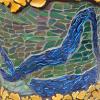Uncovered Perspectives: Jason Thrasher Revisits India Through Photography
Art Notes

"Trains," outside Mumbai.
In 1998, local photographer Jason Thrasher crowdfunded a four-month trip to India, where he captured images that today offer a glimpse into a time and place on the brink of massive change and technological advancement. Curated by Lauren Fancher at the Athens Institute for Contemporary Art, “Jason Thrasher | Uncovered Perspectives: India 21 Years Later” is an exhibition that contemplates memory, growth and change, not only within a country, but within photography as a medium.
Thrasher had just graduated from art school at UGA and was working downtown at The Globe, where he would frequently meet exchange students from various countries, when he had a vivid dream about taking a trip around the world. The next morning, while meeting with Charlie Mustard, Jittery Joe’s beloved coffee roaster, to take portraits of his baby daughter, Thrasher mentioned his dream and mused about the possibility of pre-selling photographs to cover travel expenses. As the story goes, Mustard volunteered on the spot to buy two prints and rallied several other friends to pull together a commitment of $500 by the end of the day. After a few months during which Thrasher was able to raise around $5,000, he bought a Leica camera, 100 rolls of film and a plane ticket to India, Thailand and Vietnam, destinations he gravitated towards through his interests in yoga and Tibetan Buddhism.
“My main goal in India was not to photograph the typical Indian scene. I didn’t really photograph people in prayer, or bathing on the banks of the Ganges, or perfect sunrises, or bright colors—one of the reasons I chose black-and-white film,” says Thrasher, who was 28 at the time. “My main goal was to make photographs in search of who I would have been if I had been born and raised in India as a young man.”
The seed for a new exhibition was planted last fall on the 20th anniversary of his journey. While reflecting on the life-changing significance of his travels through revisiting the body of work, he decided to post an image and backstory on social media each day, a routine that coincided with a refocus on his meditation and yoga practices.
“I would spend about 20–30 minutes each morning sitting quietly and attempting to meditate, but mostly thinking about the image I was going to work on and share that day,” said Thrasher. “I went back into the negatives for the first time in 18 or 19 years, and also looked back at my journal from the trip. Also, with YouTube and Google Maps, I was able to find and examine closely some of the locations of my photographs, and watch video of almost everywhere I went. So, the memories all came flooding back. At the end of the process, I felt like I had gone on a whole new trip.”
Interestingly, revisiting the negatives presented a new opportunity to bring formerly imperfect images to new life through advances in digital editing software. Original black-and-white 35mm negatives were scanned, then cleaned up to remove any dust or scratches. Using Lightroom, Thrasher was then able to adjust very specific aspects of each image, like contrast, lighting, burning or dodging, that were not possible in the original dark room.
“I’m very excited about the wall of 16 images from the trains, and a wall of nine images about water, but I’m most excited about the long wall with 44 images from Varanasi,” he says. “It’s easily the best series of photos I’ve ever made, and it all centers on one street corner just up the hill from the famous burning ghats on the Ganges—Varanasi, or Benares, as it’s also known—it’s one of the oldest continually inhabited cities in the world. I shot about 35 rolls of film in Varanasi over two weeks. My new goal is to go back to this spot and see if I can find some of these old friends.”
An opening reception for “Uncovered Perspectives” will be held Sunday, Oct. 13 from 5–8 p.m. An evening of experimental music, coordinated by Kathryn Koopman and featuring members of Thunder O(h)m!, will take place in the gallery on Saturday, Oct. 19 at 7 p.m. An additional performance, held on Tuesday, Oct. 22 at 6 p.m., will spotlight the Vimadean Duo, a violin and marimba pair originally from Moscow. The exhibition’s final day will include an artist talk and closing event coinciding with Diwali, the Indian Festival of Lights, on Sunday, Oct. 27 at 4 p.m.
Calendar
-
Sunday, October 13
ATHICA
Opening Reception
In 1998, Jason Thrasher crowd-sourced a months-long trip to India by pre-selling darkroom prints of the photographs he would make there and on his return exhibit as an enduring body of work. This trip coincided with the arrival of the Internet in India and the dawn of massive changes across the country that would occur over the next two decades. 20 years later, the negatives have been made clearer through new digital techniques in the exhibition "Jason Thrasher | Uncovered Perspectives: India 21 Years Later." See Art Notes on p. 12.
Keywords
More by Jessica Smith
-

Art Around Town
A list of local art exhibits.
-

-

Art Around Town
A list of local art exhibits.









comments